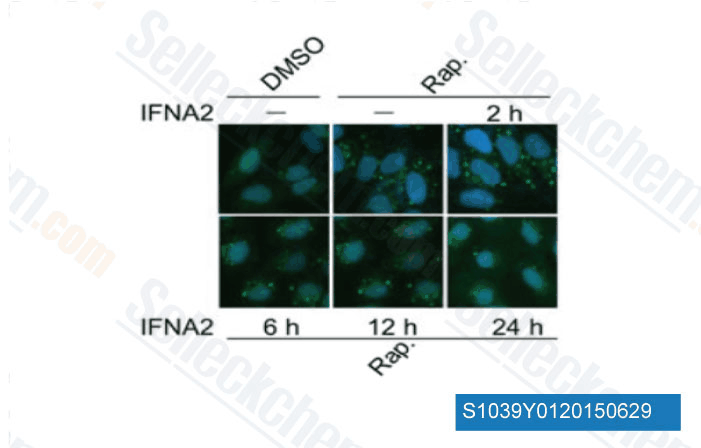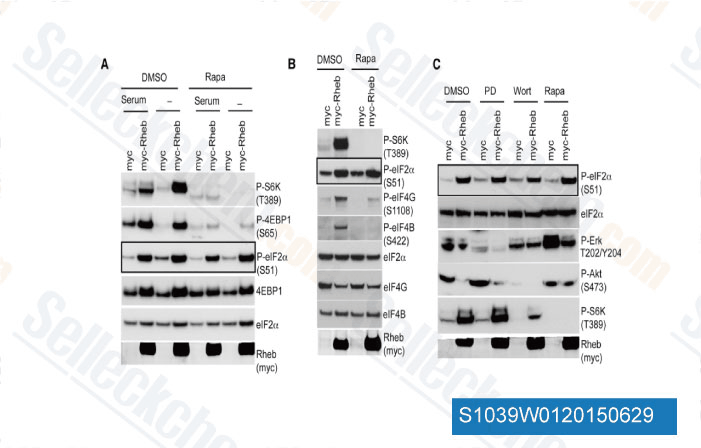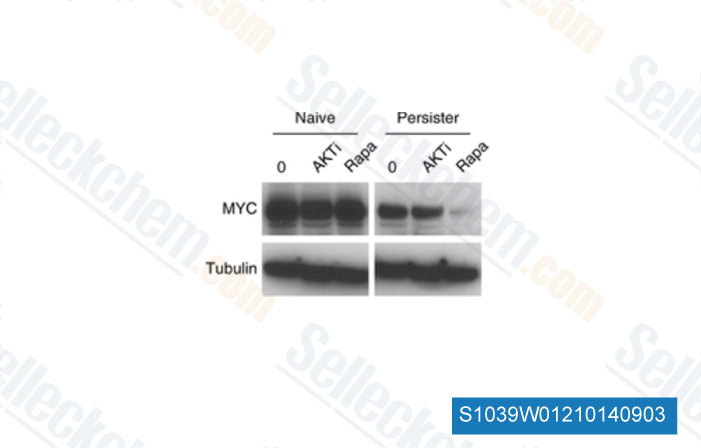|
Toll Free: (877) 796-6397 -- USA and Canada only -- |
Fax: +1-832-582-8590 Orders: +1-832-582-8158 |
Tech Support: +1-832-582-8158 Ext:3 Please provide your Order Number in the email. |
Technical Data
| Formula | C51H79NO13 |
|||
| Molecular Weight | 914.18 | CAS No. | 53123-88-9 | |
| Solubility (25°C)* | In vitro | DMSO | 100 mg/mL (109.38 mM) | |
| Ethanol | 100 mg/mL (109.38 mM) | |||
| Water | Insoluble | |||
|
* <1 mg/ml means slightly soluble or insoluble. * Please note that Selleck tests the solubility of all compounds in-house, and the actual solubility may differ slightly from published values. This is normal and is due to slight batch-to-batch variations. * Room temperature shipping (Stability testing shows this product can be shipped without any cooling measures.) |
||||
Preparing Stock Solutions
Biological Activity
| Description | Rapamycin (Sirolimus) is a specific mTOR inhibitor with IC50 of ~0.1 nM HEK293 cells.Rapamycin binds to FKBP12 and specifically acts as an allosteric inhibitor of mTORC1. Rapamycin is an autophagy activator and an immunosuppressant. | ||
|---|---|---|---|
| Targets |
|
||
| In vitro | Rapamycin inhibits endogenous mTOR activity in HEK293 cells with IC50 of ~0.1 nM, more potently than iRap and AP21967 with IC50 of ~5 nM and ~10 nM, respectively. [1] In Saccharomyces cerevisiae, Rapamycin treatment induces a severe G1/S cell cycle arrest and inhibition of translation initiation to levels below 20% of control. [2] Rapamycin significantly inhibits the cell viability of T98G and U87-MG in a dose-dependent manner with IC50 of 2 nM and 1 μM, respectively, while displaying little activity against U373-MG cells with IC50 of >25 μM despite the similar extent of the inhibition of mTOR signaling. Rapamycin (100 nM) induces G1 arrest and autophagy but not apoptosis in Rapamycin-sensitive U87-MG and T98G cells by inhibiting the function of mTOR. [3] |
||
| In vivo | Treatment with Rapamycin in vivo specifically blocks targets known to be downstream of mTOR such as the phosphorylation and activation of p70S6K and the release of inhibition of eIF4E by PHAS-1/4E-BP1, leading to complete blockage of the hypertrophic increases in plantaris muscle weight and fibre size. [4] Short-term Rapamycin treatment, even at the lowest dose of 0.16 mg/kg, produces profound inhibition of p70S6K activity, which correlates with increased tumor cell death and necrosis of the Eker renal tumors. [5] Rapamycin inhibits metastatic tumor growth and angiogenesis in CT-26 xenograft models by reducing the production of VEGF and blockage of VEGF-induced endothelial cell signaling. [6] Rapamycin treatment at 4 mg/kg/day significantly reduces tumor growth of C6 xenografts, and tumor vascular permeability. [7] |
Protocol (from reference)
| Kinase Assay: |
|
|---|---|
| Cell Assay: |
|
| Animal Study: |
|
References
Customer Product Validation

-
Data from [Data independently produced by Autophagy, 2015, 11(4), 617-28]

-
Data from [Data independently produced by Cell Rep, 2015, 10.1016/j.celrep.2015.01.014]

-
Data from [Data independently produced by Biochem Pharmacol, 2015, 95(3), 156-69]

-
Data from [Nat Genet, 2014, 46(4), 364-70]
Selleck's Rapamycin (Sirolimus) has been cited by 1956 publications
| Methylation of GPRC5A promotes liver metastasis and docetaxel resistance through activating mTOR signaling pathway in triple negative breast cancer [ Drug Resist Updat, 2024, 73:101063] | PubMed: 38335844 |
| PD-L1-expressing tumor-associated macrophages are immunostimulatory and associate with good clinical outcome in human breast cancer [ Cell Rep Med, 2024, 5(2):101420] | PubMed: 38382468 |
| Stem cell factor and cKIT modulate endothelial glycolysis in hypoxia [ Cardiovasc Res, 2024, cvae058] | PubMed: 38507654 |
| 5-HT7R enhances neuroimmune resilience and alleviates meningitis by promoting CCR5 ubiquitination [ J Adv Res, 2024, S2090-1232(24)00079-1] | PubMed: 38432392 |
| Inhibiting autophagy enhanced mitotic catastrophe-mediated anticancer immune responses by regulating the cGAS-STING pathway [ Cancer Lett, 2024, 586:216695] | PubMed: 38325769 |
| Cell-intrinsic PD-L1 ablation sustains effector CD8+ T cell responses and promotes antitumor T cell therapy [ Cell Rep, 2024, 43(2):113712] | PubMed: 38294903 |
| Chronic hypoxia stabilizes 3βHSD1 via autophagy suppression [ Cell Rep, 2024, 43(1):113575] | PubMed: 38181788 |
| XBP1-mediated transcriptional regulation of SLC5A1 in human epithelial cells in disease conditions [ Cell Biosci, 2024, 14(1):27] | PubMed: 38388523 |
| Skeletal muscle regeneration after extensive cryoinjury of caudal myomeres in adult zebrafish [ NPJ Regen Med, 2024, 9(1):8] | PubMed: 38378693 |
| PLEKHM2 deficiency induces impaired mitochondrial clearance and elevated ROS levels in human iPSC-derived cardiomyocytes [ Cell Death Discov, 2024, 10(1):142] | PubMed: 38490981 |
RETURN POLICY
Selleck Chemical’s Unconditional Return Policy ensures a smooth online shopping experience for our customers. If you are in any way unsatisfied with your purchase, you may return any item(s) within 7 days of receiving it. In the event of product quality issues, either protocol related or product related problems, you may return any item(s) within 365 days from the original purchase date. Please follow the instructions below when returning products.
SHIPPING AND STORAGE
Selleck products are transported at room temperature. If you receive the product at room temperature, please rest assured, the Selleck Quality Inspection Department has conducted experiments to verify that the normal temperature placement of one month will not affect the biological activity of powder products. After collecting, please store the product according to the requirements described in the datasheet. Most Selleck products are stable under the recommended conditions.
NOT FOR HUMAN, VETERINARY DIAGNOSTIC OR THERAPEUTIC USE.
